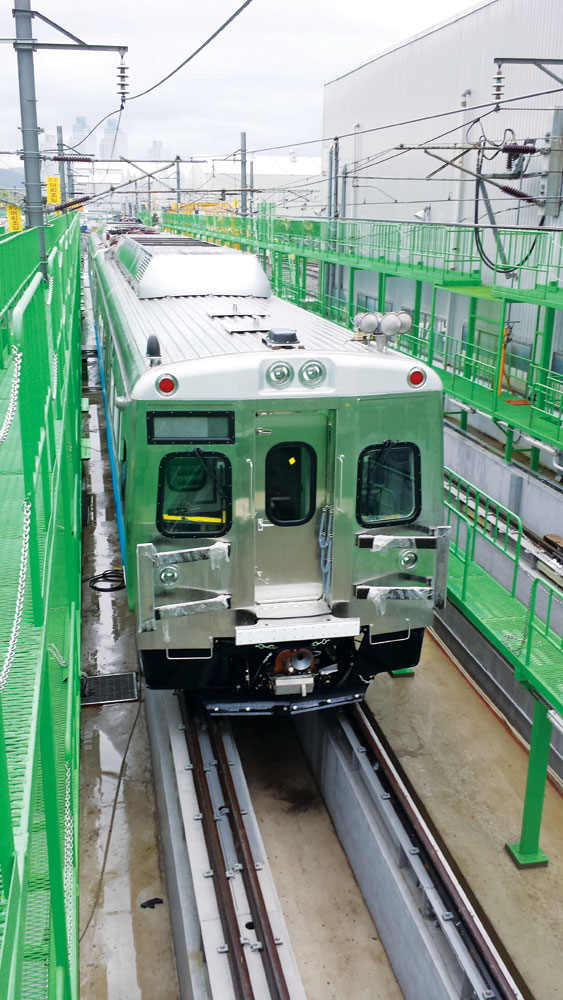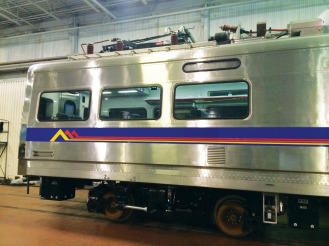To riders, the East Rail Line will just be a fast, convenient way to get to Denver International Airport (and other destinations). But to Denver Transit Partners (DTP), the RTD contractor in charge of three new commuter lines, it means years of planning, testing and training to provide a safe and enjoyable ride.
Under the Eagle P3 (public-private partnership) contract, DTP will build, operate and maintain the East Rail Line to DIA as well as the Gold Line to Arvada and Wheat Ridge, the Northwest Rail Line to Westminster and the Commuter Rail Maintenance Facility. Per their contract with RTD, DTP will, for 29 years, manage the lines that carry the heavier commuter trains. RTD oversees the existing light rail lines, marketing and ridership for all lines.

The pilot cars (the first four cars of the Eagle P3 order) have undergone testing (shown above) and are ready for shipment from Philadelphia to Denver. RTD hopes to have an open house for the public to tour one of the trains by the end of the year.
Although the commuter train and Amtrak lines are not shared, they do physically connect to the National Rail Network at Denver Union Station, putting them under the jurisdiction of the Federal Railroad Administration (FRA), the main regulators for railroads in the country. “The FRA puts a very stringent set of requirements on us in terms of safety, craft worthiness of the vehicle, how well the braking systems work and many other kinds of requirements,” says Peter Strange, system integration manager for Denver Transit Partners.

The pilot cars (the first four cars of the Eagle P3 order) have undergone testing (shown above) and are ready for shipment from Philadelphia to Denver. RTD hopes to have an open house for the public to tour one of the trains by the end of the year.
Convenience features for the trains were influenced by future riders. In 2011, a mock-up of a representative, one-third-size car was put up in front of Denver Union Station. The public was invited to try it out, ask questions and give feedback. Based on those suggestions, a number of modifications were made including increased space for luggage, bikes and skis; interior spaciousness; and a larger doorway for wheelchair users. Riders will be able to get on and off the trains seamlessly, even with a wheelchair or stroller because the trains are flush with the station platforms. While convenient, that is also one of the trains’ many safety features.
The cars themselves are designed to meet crash worthiness. “They are a very strong steel structure people are going to be inside of with materials and equipment that pose a very low fire and toxicity risk,” says Strange.
Trains and train platforms will be monitored and recorded on closed circuit TV with the train operator able to see who is getting on and off the train. The operator is the main staff member responsible for safety of passengers, but there will also be uniformed inspectors and security people roaming the trains at all times.
There are several backup systems in place throughout the commuter trains. “Lights are backed up multiple times over, so if there’s a loss of power, the lights stay on,” says Strange. The trains are also fitted with a system that shows the operator the maximum allowable speed and all upcoming stops, even unexpected ones. If the operator doesn’t adhere to the correct speed or stops, the system kicks in and does it for them. The stringent safety systems are all part of Positive Train Control (PTC), nationwide requirements that fall under FRA regulations.
Trains will be placed on tracks by early summer 2015 for initial testing. Regulations require each of the 50 trains on all three lines to have 1,000 miles of testing and training time before they can go into service, which is expected to start early summer 2016, with the East Line first, followed by the other two lines over the course of the summer.
To encourage public safety, the DTP will implement Operation Lifesaver next year, a community outreach campaign to school children who live within one-half mile of the tracks in each direction to teach them about the dangers of playing around the tracks and how to cross tracks safely. Prior to initial testing of trains, they will also reach out to neighborhood associations, senior centers and other groups who could potentially be pedestrians in the area of the tracks.




0 Comments